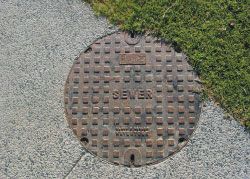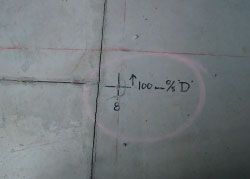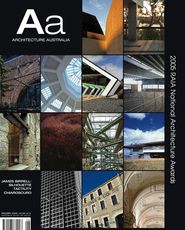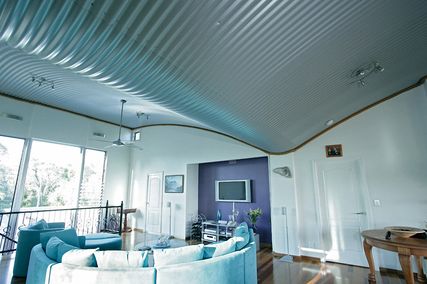For Paul Griffin, contract administration is that sub-plot of architecture practised only by those who have a genuine and deep love of the art of architecture and the beauty of the built form.

Sewer pits are things of beauty and joys to behold.

Cunning faux-paving detail to grease trap lid, in Autumn.

Interpretation of architect’s detail drawing on a construction site.
From a day in the life of a contract architect …
The most depressing thought was that they all believed an architect should be interested in grease traps.
The first phone call was from the site manager. It was about a very important question – at least to him. It concerned the capacity of the grease trap, the R.L. of its lid and the invert level of its inlet. I listened politely, but slammed down the phone before he could ask me once more about reglets in the precast concrete panels. I had already passed that query on to the structural engineer, and he was not talking. Some things are apparently too private to be spoken of publicly.
I initiated the second phone call. The hydraulics consultant. Back in the good old days, he would have been a plumbing consultant. But now she prefers to be known as an hydraulics consultant. I chuckle every time I look at her drawings, for there, right on the title blocks, in bold seven millimetre Helvetica font, are the drawing numbers: “P.01”, “P.02” etcetera. Not “H”, “P”. The drawings expose the truth, she really is a plumbing consultant!
My plumbing consultant was amazed that the site manager was asking me about the grease trap. “Doesn’t he read the drawings?” she asked. Then she read the drawings and the phone went silent for a while. I love it when the phone goes silent. It gives me time to stare into the middle distance. My hydraulics consultant cleared her throat and moaned quietly, “I’ll get back to you”. The line went dead.
The third in this series of phone calls was from the client. It is always amazing how quickly clients can discover things we do not want them to know. They are never interested in inviting us out to lunch, but mention the words “grease trap” and they show extraordinary concern. Following my most admirable explanation of the various pros and cons of the grease trap, taking on board the various suggestions the client had for that grease trap and explaining, with due deference, why the grease trap was located where it was located and why it had to stay there, I was convinced my client believed I knew everything there was to know about grease traps. And invert levels. Or that my client thought I was a complete idiot and knew nothing about grease traps. Or invert levels. I am never sure about clients. Sometimes they can treat us architects like gods and sometimes they can treat us as though we are complete idiots. It is all for the best, really, for most architects are complete idiots and it is much easier for the majority of us not to pretend we are gods when complete idiocy will ›› do just as well. And earn us the same paltry fees.
Be they gods or idiots, I do not believe many architects have been intimate with a grease trap. I certainly have not. I have seen many of them lowered into position and have stood, with sage-like knowledge, on the lids of many more, but have no wish to peer into the bowels of one to contemplate its inner workings. I do know what an invert level is, or at least did during Surveying 203 some thirty-three years ago, but that is it.
After that third phone conversation, I sat back in my ten-years-old typist chair and gazed with child-like wonderment at the laughter and gaiety flowing from the designers’ quadrant of the office. How sweet life must be to encompass the full experience of architecture without any knowledge of grease traps!
I know Design Architects encompass the full experience of architecture because their CVs say so. I know their CVs say so because I have to read them each time I audit the Staff Qualifications section of the firm’s Quality Management System. I audit the Staff Qualifications Section of the firm’s Quality Management System because I wrote the firm’s Quality Management System. Now, that is an exercise only slightly better than climbing naked into a grease trap with the site manager for a discussion about whether the aforesaid grease trap should be converted into an acid pit. Not that that has ever happened, of course.
The Contract Administration end of the project is also that part of the project that the office accountant always claims is losing the firm money. Every time. Without fail. Those glaring accusations of incompetence and time wasting are not lost on your typical 60-hoursa- week, always-on-call Contract Administration Architect.
We feel true contrition and absolute guilt for servicing the project with professionalism; for answering innumerable Technical Queries on dimensions, accessible toilets layouts, and mechanical services ductwork; for writing Contract Variations, Superintendent’s Instructions, and Progress Certificates; and for investigating the designs, structures, colours and installations of flashings. Oh, yes, flashings!
Doesn’t it all boil down to the simple mission statement of architecture? That all us architects ever want to do is to build something that is pretty? And if it doesn’t leak, that is an added bonus. The only problem is that grease traps, reglets, cat 5 cables, re-entry bars, backward-curve fans, chemical anchors and Quality Management Systems all seem to get in the way. It is therefore not surprising that Contract Administration Architects have no time for gaiety or laughter and why we are such a sullen and unattractive lot.
Paul Griffin is a senior architect and computer manager at Jones Coulter Young. He suggests that future columns may explore other typical days in the life of a contract administration architect, including conflict resolution during site meetings; the FINA.















